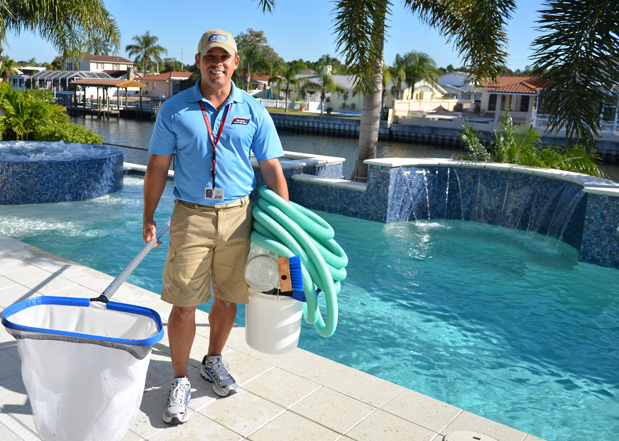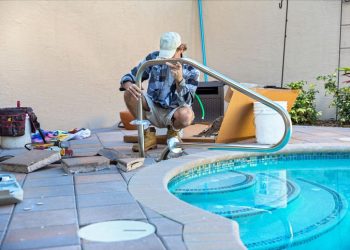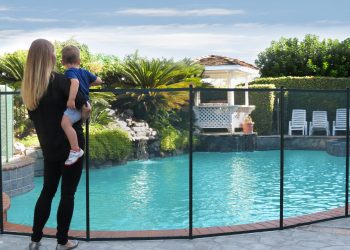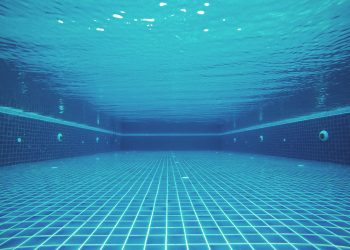Table of Contents
Having a swimming pool can significantly enhance the beauty of your home. It doesn’t only attract the guests but also keeps your family members fit and healthy.
However, while a pool with nice and clean water can be enjoyable, a cloudy and dirty one can be precisely the opposite. Ignoring the pool for a long time can cause an overgrowth of algae, making your pool green and murky.

If the pool is not cleaned in time, the algae will increase in number, making it almost impossible to swim. That’s why it’s essential to clean it regularly and make it ready for the swim.
Why Your Pool Becomes Green?
Most of the time, the pool becomes dirty and green due to an overgrowth of algae. There are so many reasons for the algae to grow, such as-
Clogged Filter
It’s crucial to check the filter regularly to see whether it’s working or not. A clogged filter will not only help the algae to grow but will also breed some bacteria and debris and eventually make the water green.
Poor pH Balance
Having too low or too high pH levels can be the reason for water discoloration. A very low level of pH can cause eye irritation and erode inferior materials. On the other hand, very high pH levels can be a breeding ground for bacteria and algae.
Change In Temperature
Algae can easily thrive in hot and humid weather, meaning that if there’s any change in the climate where you live, you need to take extra care of your pool.
While algae aren’t poisonous, they can easily host some deadly bacteria such as E.Coli. That’s why you should keep the tank clean.
How to Keep Your Swimming Pool Clean
Depending on the growth of algae and other debris, there are six simple steps that you need to follow to clean the pool and make it suitable for swimming.
Clean The Debris
If your pool has just started to become dirty, you can clean it yourself. Start by removing the debris to make the algae deprived of a food source.
However, if the water is extraordinarily green and cloudy, and you can’t see at least six to eight inches below the water surface, you may need to drain it and go for an acid wash. In that case, call a professional instead of doing it yourself.
Keep A Healthy pH Level
To keep a healthy pH level of the water, first, you need to calculate the concentration. There are some test kits available in the market, which you can try.
Remember, for this project, your ideal pH should be 7.2 or lower. You may need to use muriatic acid if the level is too high.
You will also know that the chlorine level is too low if you see the pool is green. Check the cyanuric acid (CYA) level and make sure it’s not lower than 30 ppm.
However, if the CYA is too high, you have to drain all the water and fill the pool with fresh water.
Shock Your Pool
Once the water reaches its perfect pH level, you need to shock the pool. It’s a method that involves adding a bunch of super shock liquid chlorine to the water to kill off the debris and algae.
You will have to chlorinate the pool to 30 ppm to de-structure the DNA of the algae. Test the chlorine level at least twice a day, and add more chlorine until the water becomes crystal clear.
Brush, Pump, & Filter
After 24 hours of adding chlorine, you will see a cleaner pool with some dead algae that you need to clean. You need to brush the walls, ladders, and everything else to make sure no debris is left. Keep the pump running while you’re doing this.
You can use a manual or robotic pool cleaner to remove the algae. To learn more about a robotic pool cleaner, go to https://roboticpoolcleaner.org/polaris-pool-cleaners/polaris-360-review/, and get a thorough understanding of how it can make your life easy when it comes to clean the water tank.
To make the water crystal clear, vacuum it several times a day while your pool is under the shock process.
Test For Chlorine Loss
Once the cleaning and vacuuming are done, you need to check if there are any algae left. You can do it by conducting an overnight chlorine loss test or OCLT.
Since both algae and sun will consume the chlorine, do it after the sun goes down and the next morning before the sun rises.
You need to continue performing this chlorine testing process until you find the chlorine level remains the same or has dropped just less than 1 point.
Keep The Maintenance Running
Since you’ve got rid of most of the algae, it’s time to keep it that way. Don’t forget to test your pool water regularly, preferably once a day. If not possible, at least check it once per week.
You will have to stock up on all the essential chemicals to make adjustments when needed. Make sure the CYA, free chlorine, and pH are at acceptable levels.
It’s crucial to invest in an excellent chlorinating system to keep the optimum level of chlorine in the pool at all times. Brush, clean, and vacuum the pool at least once a week. Wash your pool filter regularly and upgrade it when needed.
Final Thoughts
Cleaning your pool might sound like a tedious job, but things will become even worse if you don’t clean them often. Algae and debris will grow consistently, making your pool so dirty that it will be difficult to clean.
We all know that prevention is better than cure, and it’s also true when it comes to swimming pool maintenance. The more you keep it clean, the fewer algae will grow, allowing you and your family to enjoy excellent pool time.







